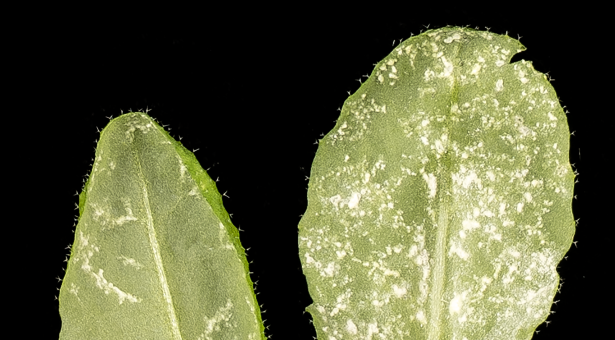A new Achilles Heel gene discovered in plant-pathogen interactions

Pathogens can subvert the functions of many types of plant host proteins to facilitate their growth and reproduction.
In most plants these proteins are guarded by specific intracellular receptors that detect meddling by pathogen effector proteins and trigger cell death to halt infection.
A research collaboration has identified members of the DA1 family of growth-regulatory enzymes as targets of effectors secreted by the oomycete pathogen Albugo candida, which causes white blister rust, a widespread disease of Brassica crops.
Experiments and genomic analysis showed that Albugo growth in susceptible Arabidopsis accessions requires DA1 activity. This is promoted during Albugo infection by the degradation of DAR3 which inhibits DA1 activity.
They propose that a putative effector from Albugo is involved in DAR3 destabilisation. In resistant plants DAR3 is guarded by the paired immune receptor CSA1-CHS3/DAR4 containing an Integrated Domain derived from DAR3.
The work is significant because it helps to explain the functions of immune receptors and adds to the range of mechanisms that are subverted by pathogens to facilitate their growth.
Dr Benguo Gu, working with Professor Mike Bevan in The Cell and Developmental Biology Dept, at the John Innes Centre said: “We have discovered a new Achilles Heel in Arabidopsis that modulates growth in response to infection by the white rust pathogen.
“By linking the DA1 growth regulatory mechanism to pathogen effector action, this work enlarges the range of regulatory mechanisms targeted by pathogens and adds to our knowledge of plant growth in the environment”.
The research which appears in Cell Host Microbe is a collaboration between the John Innes Centre, Professor Jonathan Jones Jonathan Jones group in The Sainsbury Laboratory, Volkan Cevik’s group at the University of Bath and Detlef Weigel’s group in Tubingen.
Defining mechanisms that modulate plant growth in response to environmental cues (such as pathogens) is a central objective of the GEN ISP (Institute Strategic Programme).
The article appears in Cell Host Microbe



